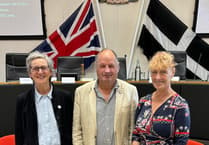DID you manage to get a good view of the lunar eclipse on September 7? For once, the rainclouds cleared to give those watching a very special evening experience. Thanks to Simon Tagney for the picture accompanying this column. Eclipses occur in pairs, so the lunar event was followed by a partial solar eclipse; the downside was that to see it meant a quick trip to Antarctica, and Simon wasn’t willing do that!
October is a good night for observing as it gets dark fairly early, and it’s not too cold.
At the time of writing, the Sun has a big hole in it and we are being hit by a high speed solar storm. In turn, this means the aurora can be seen more widely. For the latest situation, keep an eye on Spaceweather.com
The phases of the moon are as follows: Full moon, October 7; last quarter, October 13; New moon, October 21; first quarter, October 29. This month’s full moon is known as the Harvest Moon, because it rises around sunset for several consecutive nights and historically allowed farmers to work longer hours during harvest time.
In the planets, Mercury can be seen after sunset together with Mars, while Venus is a bright predawn object.
British Summer Time (BST) ends on October 25 – put your clocks bacjk and enjoy an hour longer in bed!
There are a couple of comets about. The first is 3 i Atlas - the i stands for interstellar and means it has come from a solar system other than our own, and in fact is only the third such object to be found. The second is Swan25B, and could be a nice view if it survives its trip around the sun.
Brian Sheen runs Roseland Observatory, which is based at Truro High School for Girls.





Comments
This article has no comments yet. Be the first to leave a comment.